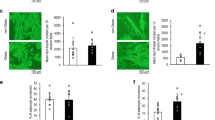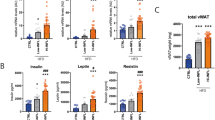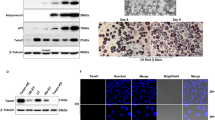Abstract
Objective:
The objective of this study was to investigate the molecular mechanisms underlying adenovirus-36 (Ad-36)-induced obesity by the identification of novel genes and cellular pathways.
Design:
Viral growth, intracellular lipid accumulation and gene expression profiles were determined in human mesenchymal stem cells (hMSCs) infected with Ad-36 or Ad-2. A microarray assay and gene set enrichment analysis (GSEA) were performed to assess alterations in global gene expression profiles.
Results:
Ad-36, but not Ad-2, induced lipid accumulation and upregulated adipogenesis-related genes. There was no difference in viral growth between Ad-36 infection and Ad-2 infection in hMSCs. GSEA revealed that Ad-36 infection was more frequently associated with activation of novel pathways, including the PPAR-gamma signaling pathway, and inflammation compared with Ad-2 infection, raising the possibility that these pathways may be key regulators of Ad-36-induced adipogenesis.
Conclusion:
This study may help foster a better understanding of the roles of several cellular factors in Ad-36-induced obesity.
This is a preview of subscription content, access via your institution
Access options
Subscribe to this journal
Receive 12 print issues and online access
$259.00 per year
only $21.58 per issue
Buy this article
- Purchase on Springer Link
- Instant access to full article PDF
Prices may be subject to local taxes which are calculated during checkout




Similar content being viewed by others
References
Atkinson RL . Viruses as an etiology of obesity. Mayo Clin Proc 2007; 82: 1192–1198.
Whigham LD, Israel BA, Atkinson RL . Adipogenic potential of multiple human adenoviruses in vivo and in vitro in animals. Am J Physiol Regul Integr Comp Physiol 2006; 290: R190–R194.
Pasarica M, Dhurandhar NV . Infectobesity: obesity of infectious origin. Adv Food Nutr Res 2007; 52: 61–102.
Dhurandhar NV, Israel BA, Kolesar JM, Mayhew G, Cook ME, Atkinson RL . Transmissibility of adenovirus-induced adiposity in a chicken model. Int J Obes Relat Metab Disord 2001; 25: 990–996.
Atkinson RL, Dhurandhar NV, Allison DB, Bowen RL, Israel BA, Albu JB et al. Human adenovirus-36 is associated with increased body weight and paradoxical reduction of serum lipids. Int J Obes (Lond) 2005; 29: 281–286.
Na HN, Hong YM, Kim J, Kim HK, Jo I, Nam JH . Association between human adenovirus-36 and lipid disorders in Korean school children. Int J Obes (Lond) 2010; 34: 89–93.
Atkinson RL, Lee I, Shin HJ, He J . Human adenovirus-36 antibody status is associated with obesity in children. Int J Pediatr Obes 2010; 5: 157–160.
Trovato GM, Martines GF, Garozzo A, Tonzuso A, Timpanaro R, Pirri C et al. Ad36 adipogenic adenovirus in human non-alcoholic fatty liver disease. Liver Int 2010; 30: 184–190.
Gabbert C, Donohue M, Arnold J, Schwimmer JB . Adenovirus 36 and obesity in children and adolescents. Pediatrics 2010; 126: 721–726.
Rogers PM, Fusinski KA, Rathod MA, Loiler SA, Pasarica M, Shaw MK et al. Human adenovirus Ad-36 induces adipogenesis via its E4 orf-1 gene. Int J Obes (Lond) 2008; 32: 397–406.
Wang ZQ, Cefalu WT, Zhang XH, Yu Y, Qin J, Son L et al. Human adenovirus type 36 enhances glucose uptake in diabetic and nondiabetic human skeletal muscle cells independent of insulin signaling. Diabetes 2008; 57: 1805–1813.
Pasarica M, Mashtalir N, McAllister EJ, Kilroy GE, Koska J, Permana P et al. Adipogenic human adenovirus Ad-36 induces commitment, differentiation, and lipid accumulation in human adipose-derived stem cells. Stem Cells 2008; 26: 969–978.
Janderova L, McNeil M, Murrell AN, Mynatt RL, Smith SR . Human mesenchymal stem cells as an in vitro model for human adipogenesis. Obes Res 2003; 11: 65–74.
De Bari C, Dell’Accio F, Tylzanowski P, Luyten FP . Multipotent mesenchymal stem cells from adult human synovial membrane. Arthritis Rheum 2001; 44: 1928–1942.
Nakamura T, Shiojima S, Hirai Y, Iwama T, Tsuruzoe N, Hirasawa A et al. Temporal gene expression changes during adipogenesis in human mesenchymal stem cells. Biochem Biophys Res Commun 2003; 303: 306–312.
Dhurandhar NV, Israel BA, Kolesar JM, Mayhew GF, Cook ME, Atkinson RL . Increased adiposity in animals due to a human virus. Int J Obes Relat Metab Disord 2000; 24: 989–996.
Vangipuram SD, Sheele J, Atkinson RL, Holland TC, Dhurandhar NV . A human adenovirus enhances preadipocyte differentiation. Obes Res 2004; 12: 770–777.
Subramanian A, Tamayo P, Mootha VK, Mukherjee S, Ebert BL, Gillette MA et al. Gene set enrichment analysis: a knowledge-based approach for interpreting genome-wide expression profiles. Proc Natl Acad Sci USA 2005; 102: 15545–15550.
Pasarica M, Shin AC, Yu M, Ou Yang HM, Rathod M, Jen KL et al. Human adenovirus 36 induces adiposity, increases insulin sensitivity, and alters hypothalamic monoamines in rats. Obesity (Silver Spring) 2006; 14: 1905–1913.
Dhurandhar NV, Whigham LD, Abbott DH, Schultz-Darken NJ, Israel BA, Bradley SM et al. Human adenovirus Ad-36 promotes weight gain in male rhesus and marmoset monkeys. J Nutr 2002; 132: 3155–3160.
Oberkofler H, Dallinger G, Liu YM, Hell E, Krempler F, Patsch W . Uncoupling protein gene: quantification of expression levels in adipose tissues of obese and non-obese humans. J Lipid Res 1997; 38: 2125–2133.
Rosen ED, Hsu CH, Wang X, Sakai S, Freeman MW, Gonzalez FJ et al. C/EBPalpha induces adipogenesis through PPARgamma: a unified pathway. Genes Dev 2002; 16: 22–26.
Chmurzynska A . The multigene family of fatty acid-binding proteins (FABPs): function, structure and polymorphism. J Appl Genet 2006; 47: 39–48.
Yang WS, Lee WJ, Huang KC, Lee KC, Chao CL, Chen CL et al. mRNA levels of the insulin-signaling molecule SORBS1 in the adipose depots of nondiabetic women. Obes Res 2003; 11: 586–590.
Ribon V, Printen JA, Hoffman NG, Kay BK, Saltiel AR . A novel, multifuntional c-Cbl binding protein in insulin receptor signaling in 3T3-L1 adipocytes. Mol Cell Biol 1998; 18: 872–879.
Kim JY, van de Wall E, Laplante M, Azzara A, Trujillo ME, Hofmann SM et al. Obesity-associated improvements in metabolic profile through expansion of adipose tissue. J Clin Invest 2007; 117: 2621–2637.
Yamauchi T, Kamon J, Waki H, Imai Y, Shimozawa N, Hioki K et al. Globular adiponectin protected ob/ob mice from diabetes and ApoE-deficient mice from atherosclerosis. J Biol Chem 2003; 278: 2461–2468.
Pajvani UB, Hawkins M, Combs TP, Rajala MW, Doebber T, Berger JP et al. Complex distribution, not absolute amount of adiponectin, correlates with thiazolidinedione-mediated improvement in insulin sensitivity. J Biol Chem 2004; 279: 12152–12162.
Stienstra R, Duval C, Muller M, Kersten S . PPARs, obesity, and inflammation. PPAR Res 2007; 2007: 95974.
Shoelson SE, Herrero L, Naaz A . Obesity, inflammation, and insulin resistance. Gastroenterology 2007; 132: 2169–2180.
Acknowledgements
This study was supported by a grant from the GRRC of the Catholic University of Korea, the Biogreen21 Program (PJ007186) of Rural Development of Administration, MKE and KOTEF through the Human Resource Training Project for Strategic Technology, and Medical Research Center (2010-0029474) programs funded by the Ministry of Science and Technology, Republic of Korea. H-N Na was supported by Hi Seoul Science (Humanities) Fellowship funded by the Seoul Scholarship Foundation.
Author information
Authors and Affiliations
Corresponding author
Ethics declarations
Competing interests
The authors declare no conflict of interest.
Additional information
Supplementary Information accompanies the paper on International Journal of Obesity website
Rights and permissions
About this article
Cite this article
Na, HN., Kim, H. & Nam, JH. Novel genes and cellular pathways related to infection with adenovirus-36 as an obesity agent in human mesenchymal stem cells. Int J Obes 36, 195–200 (2012). https://doi.org/10.1038/ijo.2011.89
Received:
Revised:
Accepted:
Published:
Issue Date:
DOI: https://doi.org/10.1038/ijo.2011.89
Keywords
This article is cited by
-
What we know and what we need to know about adenovirus 36-induced obesity
International Journal of Obesity (2020)
-
Infectious and Environmental Influences on the Obesity Epidemic
Current Obesity Reports (2016)



